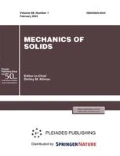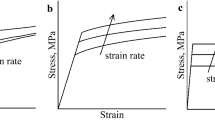Abstract
A version of the metal plasticity relaxation model based on a plasticity integral criterion with the characteristic relaxation time parameter is suggested. The dislocation concepts of metal plasticity together with the Maxwell model for a strongly viscous fluid are used to show that this characteristic relaxation time parameter can be interpreted in terms of dissipation and energy accumulation in the case of mobile dislocations. The coincidence of the values of characteristic plastic relaxation time obtained for various descriptions of the whisker deformation allows one to conclude that the characteristic relaxation time is a basic characteristic of the material dynamic properties.
Similar content being viewed by others
References
G. V. Berezhkova, Filamentary Crystals (Nauka, Moscow, 1969) [in Russian].
B. V. Petukhov, “A Theory of Sharp Yield Point in Low-Dislocation Crystals,” Zh. Tekhn. Fiz. 71(11), 42–47 (2001) [Tech. Phys. (Engl. Transl.) 46 (11), 1389–1395 (2001)].
M. A. Meyers and K. K. Chawla, Mechanical Behavior of Materials (Cambridge Univ. Press, New York, 2009).
J. R. Greer and J. Th. M. de Hosson, “Plasticity in Small-Sized Metallic Systems: Intrinsic versus Extrinsic Size Effect,” Prog. Mat. Sci. 56(6), 654–724 (2001).
A. A. Gruzdkov, E. V. Sitnikova, N. F. Morozov, and Yu. V. Petrov, “Thermal Effect in Dynamic Yielding and Fracture of Metals and Alloys,” Math. Mech. Solid 14(1–2), 72–87 (2009).
A. A. Gruzdkov, Yu. V. Petrov, and V. I. Smirnov, “An Invariant Form of the Dynamic Criterion for Yield of Metals,” Fiz. Tverd. Tela 44(11), 1987–1989 (2002) [Phys. Solid State (Engl. Transl.) 44 (11), 2080–2082 (2002)].
A. A. Gruzdkov and Yu. V. Petrov, “On Temperature-Time Correspondence in High-Rate Deformation of Metals,” Dokl. Physics 44, 114–116 (1999).
M. M. Hutchinson, “High Upper Yield Point in Mild Steel,” J. Iron Steel Inst. 186, 431–432 (1957).
S. S. Brenner, “Plastic Deformation of Copper and Silver Whiskers,” J. Appl. Phys. 28(9), 1023–1026 (1957).
R. V. Coleman, P. B. Price, and N. Cabera, “Slip of Zinc and Cadmium Whiskers,” J. Appl. Phys. 28, 1360–1361 (1957).
E. Cadoni, F. D’Aiuto, and C. Albertini, “Dynamic Behavior of Advanced High Strength Steel Used in the Automobile Structures,” DYMAT 1, 135–141 (2009).
E. N. Borodin and A. E. Mayer, “A Simple Mechanical Model for Grain Boundary Sliding in Nanocrystalline Metals,” Mat. Sci. Engng A 532, 245–248 (2012).
I.N. Borodin, A. E. Mayer, Yu.V. Petrov, and A.A. Gruzdkov, “Relaxation Mechanism of Plastic Deformation and Its Justification by an Example of Sharp Yield Point,” Fiz. Tverd. Tela 57, (2014) [Phys. Solid State (Engl. Transl.)].
V. S. Krasnikov, A. E. Mayer and A. P. Yalovets, “Dislocation Based High-Rate Plasticity Model and Its Application to Plate-Impact and Ultra Short Electron Irradiation Simulations,” Int. J. Plasticity 27(8), 1294–1308 (2011).
A. E. Mayer, K. V. Khishchenko, P. R. Levashov, and P. N. Mayer, “Modeling of Plasticity and Fracture of Metals at Shock Loading,” J. Appl. Phys. 113, 193508 (2013).
A. E. Dudorov and A. E. Mayer, “Equations of Dislocation Dynamics and Kinetics is High-Rate Plastic Deformation,” Vestnik Chelyabinsk Gos. Univ. 39(254), No. 12, 48–56 (2011).
I. S. Grigoriev and E.Z. Melikhov (Eds.), Physical Quantities. Reference Book (Energiya, Moscow, 1991) [in Russian].
Author information
Authors and Affiliations
Corresponding author
Additional information
Original Russian Text © I.N. Borodin, Yu.V. Petrov, 2014, published in Izvestiya Akademii Nauk. Mekhanika Tverdogo Tela, 2014, No. 6, pp. 41–49.
About this article
Cite this article
Borodin, I.N., Petrov, Y.V. Relaxation model of dynamic plastic deformation of materials. Mech. Solids 49, 635–642 (2014). https://doi.org/10.3103/S0025654414060041
Received:
Published:
Issue Date:
DOI: https://doi.org/10.3103/S0025654414060041



